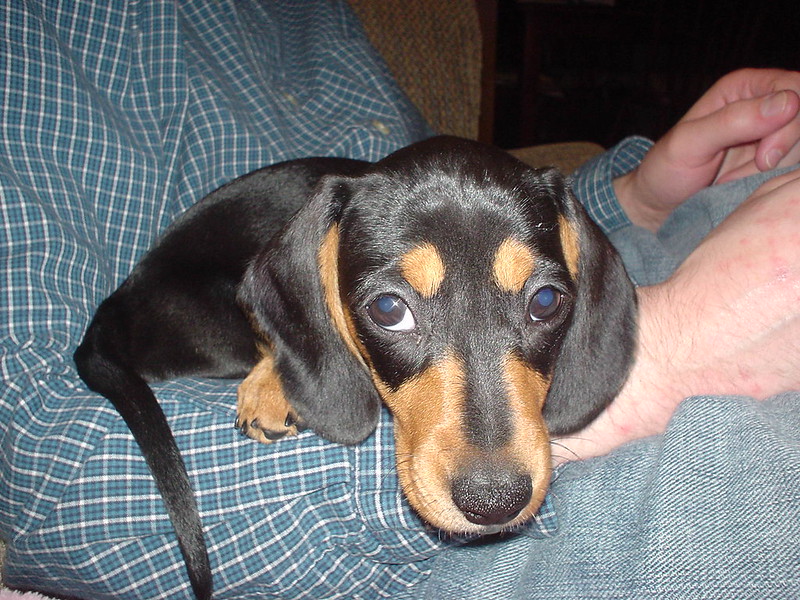How Evolution Makes Us Love Dogs

On May 21, 2006, a dog owner named Bruce uploaded the above picture of his miniature dachshund named Billie to Flickr, a photosharing website. Bruce labeled the photo “puppy dog eyes,” assumedly to highlight how Billie’s eyes make her so irresistibly cute. Even if you’re not a dog person, you have to appreciate how much love this puppy is likely to provide.
But I’m sorry to say: it’s a trick. Don’t blame the puppy, though; blame evolution.
Wolves, most people would agree, don’t make for good pets. They’re pack animals who hunt down prey, capable of taking down animals much larger than they themselves are. They also tend to dominate over the other canines in their areas; while wolves generally won’t attack coyotes without provocation (and don’t eat coyote meat typically, regardless), wolves have been known to tussle with them when the situation requires. There’s not a lot of need for us to go into his, though; all you need to know is that wolves don’t make for good pets. That’s important because as PBS notes, dogs were once wolves: “the dog, Canis familiaris, is a direct descendent of the gray wolf, Canis lupus: In other words, dogs, as we know them, are domesticated wolves.”
Over the last 100,000 years or so — relatively speaking, a very short amount of time — evolutionary changes have made what we call dogs into great pets. Dogs, as PBS continues, tend to be “smaller [than wolves] and with shorter muzzles and smaller teeth;” that is, they’re not likely to attack your livestock, your other pets, or your children. But, it turns out, dogs also gained some muscle that their wolf forefathers didn’t have: eyebrow muscles.
Making “puppy dog eyes” isn’t a difficult thing to do — we humans can do it without straining ourselves — but it does require a certain set of muscles to manipulate the position of our eyebrows. Dogs, like the one seen above, can obviously do it. Wolves, on the other hand, cannot. Take a look at this side-by-side illustration from the Atlantic and you’ll see — dogs have two muscles, labeled RAOL (retractor anguli oculi lateralis) and LOAM (levator anguli oculi medialis), that their wolf counterparts do not. It’s the latter that really wins over our hearts; as the Guardian explains, “puppy dog eyes are achieved by the LAOM raising the inner eyebrows, in some cases quite dramatically. The movement makes the eyes look larger and the face more babyish. Humans use different muscles to produce a similar expression when they are sad, which may explain why it brings out the caregiver in people.”
In other words: dog faces have evolved to get us to love them.
And there’s something potentially special, if not unique, about this evolutionary change. As the Atlantic explains, this is “the first biological evidence scientists have found that domesticated dogs might have evolved a specialized ability used expressly to communicate better with humans.” The dogs, in other words, didn’t develop these muscles to make them better hunters or to flee predators; they developed them so that we’d find them cute — and take them home with us.
That’s a bit far-fetched (pardon the slight pun), though; it’s not like evolutionary change comes from conscious choices like that. More likely, people caused dogs to evolve this way, as the New York Times notes, “scientists hypothesize that humans have unconsciously favored eyebrow-raising dogs during fairly recent selective breeding.” So next time a dog makes a wide-eyed appeal for your favor that you just can’t resist? Again, don’t blame the dog — blame your ancestors.
Bonus fact: Let’s say you’re in the grocery store and you come across an acquaintance — someone you know, but you can’t quite figure out how you know her or what her name is. She is in the same position — she knows she’s met you before, but can’t quite remember who you are or how you met. And yet, despite only knowing who the other one is on a subconscious level, you somehow connect, signaling to one another that you know the other. That’s your eyebrows at work, thanks to a phenomenon known as an “eyebrow flash.” If you see someone you think you know, your subconscious takes over, lifting your eyebrows significantly for a fraction of a second to signify this sense of kinship (and safety). Typically, if the person you eyebrow flash knows who you are (and sees the flash), they’ll subconsciously return the favor — and then you’re left asking the other person “uh, I can’t seem to recall your name, I’m sorry this is awkward, but who are you again?” Stupid eyebrows.
From the Archives: Why Mario Has a Mustache: In part, our iconic superhero has his iconic mustache because of his lack of eyebrows. Or, more accurately, the lack of eyebrows is because of the mustache.
